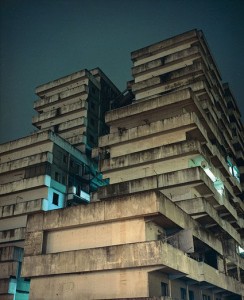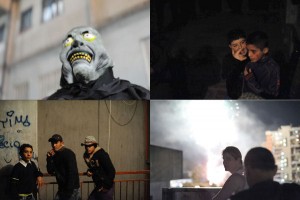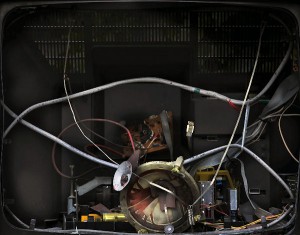by Dennis D’Alesandro
Western popular culture most often mirrors and reinforces the clean, filtered worlds of societyʼs haves. This is usually a bright and well-maintained place, where the rich and middle class go about their lives as pro-active masters of their destinies, enjoying from their desirable vantage points a close proximity to all of the resources that our cities and institutions have to offer. However, behind this one-sided veil, a vast, crumbling infrastructure looms in the shadows. Plagued by drugs, gang violence and chronic unemployment, these overlooked areas house the silent ghosts of humanity who are forced to make do the best they can in a constant struggle to overcome despite the overwhelming weight of their dilapidated environments.

Live Cinema/Peripheral Stages features the work of Mohamed Bourouissa and Tobias Zielony, two European artists whose past work has sought to give voice to the have notʼs, the people who struggle to thrive, at the lowest levels of society. At face value, the show, mainly photography plus a video by each artist, can be misconstrued as yet another cold, overly slick, brainless MFA thesis kind of show, but it doesnʼt take long to immerse yourself in the spirit of the work and its message. Indeed, the show struck me as quite powerful, successfully linking people with environment as two separate poles of a single, closed system.

Zielony presents a group of photographs which depict a beaten down and desolate housing project just north of Naples, Italy. Built in the 1960s and known as “The Sails of Scampia,” the sprawling residential complex was to become a shining example of modern utopian architecture but turned out to be a failed endeavor, never living up to the lofty vision that its architect Francesco Di Salvo had tried to instill in its cavernous design. Now completely neglected and overrun by warring mafia factions, the complex has all the trappings of a post-apocalyptic nightmare, where existential dangers seem to lurk around every corner. Still, for all the negative energy that the lugubrious buildings exude, the young Gucci-clothed denizens have a glowing human spark in their eyes that conveys a sense of cautious hope and the inevitability of human triumph. Still feeling it necessary to posture themselves toughly and to dress smartly, it almost feels like these lost gang members are waiting for somebody to walk in and tell them that it was all a joke and that theyʼll be immediately handed a better life, like what might happen on a reality tv show. Zielonyʼs 7000-frame stop motion video is equally mesmerizing. In capturing the symmetrical housing towers at night the video brings to mind the spectacular futurist imagery of Fritz Lang’s Metropolis.

French artist Mohamed Bourouissa provides a series of large-scale transparency photographs mounted in light-boxes that depicts the insides of smashed-out televisions and video monitors in a Carravaggio-like chiaroscuro stylization. Perhaps commenting on the anger and contempt for the great displayer of synthetic popular reality, Bourouissa goes behind the screen, showing us a tangled mess of worthless wires and electronics. The TV, with its supreme power to shape and control the masses, suddenly becomes marginalized and useless, divested of all its magical power. The broken TV becomes a symbol of liberation and rebelliousness, a visual battle cry for a new social revolution that is not all too different in tone from that of the Occupy protests just down the parkway. I was also impressed by Bourouissaʼs grainy cellphone video chronicling the life of a prison inmate he became acquainted with. Through text messages, he communicates with the imprisoned man, telling the man what heʼd like him to film, like for instance making the man film himself eating, or performing other lonely actions. The movie has a strange voyeuristic quality. The filmmaker at times seems like a selfish user of the incarcerated man, making him perform superfluous actions that seem to exploit the prisoner’s loneliness and clouded judgment. But in the end, as the two grow closer and more dependent on their unlikely communications, the video becomes a poignant example of humanity that prevails in the face of adversity and human relationships that endure in the most isolating of situations.

In order to thrive, human beings must adapt as best they can to the specific conditions of their immediate environment. Live Cinema/Peripheral Stages is a window into the darker, lesser known places where human beings must hustle and claw their way through the shit in order to rise above and flourish. This show was curated by Adelina Vlas and runs until January 16 in the Perelman Building of the Philadelphia Museum of Art.









